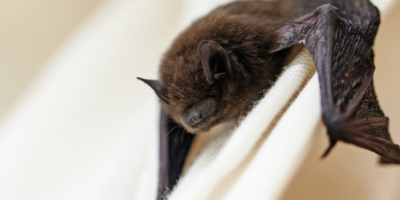Bats in the Attic: Avoiding a Major Cleanup

If you have bats in your belfry (or your attic or crawlspace—it doesn’t have to be a bell tower to be a problem), you’ll need to develop a bat exclusion system. Bat exclusion is a method of ridding and preventing bats from entering your home or business. At its simplest, bat exclusion involves covering the small holes and openings bats have been using to get into your structure with various materials depending on the scenario.
The benefit of bat exclusion is two-fold: without bats roosting in your rafters, you get to avoid the ongoing attic cleanup and, as a process, bat exclusion protects bat populations from further threat of extinction.
What Does Bat Exclusion Involve?
Basically, bat exclusion creates a one-way exit ramp for bats, ushering them away from your property by providing a way out without leaving a way back in. That way the bats can safely get out, but are also safely prevented from returning, which leaves them no other choice but to seek a different place to call home.
You might wonder why it’s necessary to go to so much trouble to protect bats via bat exclusion. After all, aren’t bats basically just rats… with wings?
That description of bats is simultaneously so close and yet so far from capturing what they are, what they mean, and what they do for the world around us.
The Benefits of Bats
But let’s start with what they are, which are mammals like us (and, yes, like rats and mice, too). However, the similarity ends there. Mice and rats are from the Order Rodentia, i.e. they’re rodents. Bats are adamantly not rodents—they actually have an order all to themselves, called Chiroptera.
But what really sets bats apart from other mammals is that they are literally the only mammals on Earth capable of true, natural flight.
Bats play an important role in world ecology. First, and most welcome from humans, is that they aid in keeping insect populations down by feasting on them. This helps prevent insect damage to crops, protects homes, and generally makes the world a nicer, more bug-free place to live.
Like bees, bats also spread pollen and seed, helping various plant species yield fruit and reproduce.
Finally, bats are known for their affinity for caves. (For the record, however, they are not “troglodytes.” Troglodytes are species for whom caves are their natural (and required) habitat. Bats are better classified as troglophiles—they love caves, but they wouldn’t die without them.) Bats help balance the delicate ecosystem that connects much of our underground water supply.
Bat Exclusion Shields Bats from Threat of Extinction
Not only are they invaluable to Earth’s precious ecosystems, unfortunately bats, especially North American bats, are on the verge of extinction as well. About ten years ago, a disease called white-nose syndrome was unintentionally introduced to the American cave system, likely by a French explorer who had tracked it across the Atlantic on his boots. Since bats have no natural immunity against white-nose syndrome, the fungal disease, which infects hibernating bats and eventually causes starvation, immediately began devastating bat populations, few of which have fully recovered.
Many local and state governments have passed strict laws regarding how you must go about ridding your property of bats to better protect them, which is why expert bat exclusion is critical.
If you’ve got bats in your belfry, attic or elsewhere, check out our bat information page and request a free estimate.



